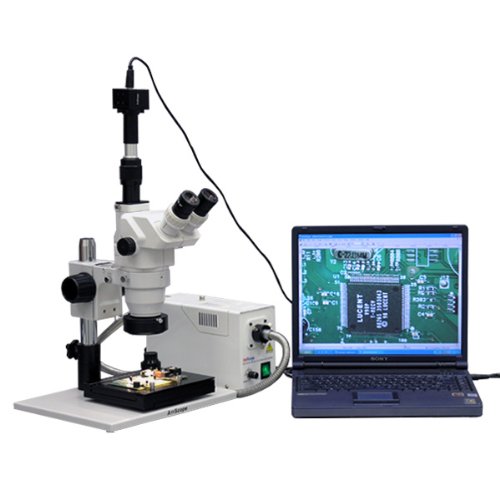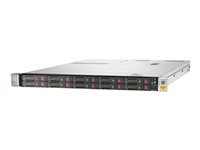Description
The AmScope ZM-1TZ2-FOR-GT-9M digital professional trinocular stereo zoom microscope has interchangeable pairs of 10x and 20x extreme-widefield high-eyepoint eyepieces, a 0.67x-4.5x zoom objective, two Barlow lenses, and a pillar stand with a gliding table. The 9MP camera has a CMOS color sensor, a reduction lens, image capture and editing software, and USB 2.0 output to capture or display still or video images on a pc or projector. The microscope has an overall magnification range of 3.35x-180x. The trinocular viewing head has an interpupillary range of 55 to 75mm, a 45-degree inclination to reduce eye and neck strain, and 360-degree rotation to enable sharing. The vertical trinocular port can be utilized as a C-Mount or 23mm photo port. The EW10x22mm and EW20x12mm extreme-widefield high-eyepoint eyepieces combine with the 0.67x-4.5x zoom objective to supply zoom magnification and a longer working distance for inspecting large-scale specimens that require handling or repair. The microscope comes with 0.5x and 2.0x Barlow lenses that may be added to the objective to increase the magnification range. A Barlow lens with a magnification of lower than 1.0 reduces magnification and increases the working distance, at the same time as a Barlow lens with a magnification greater than 1.0 increases the magnification and reduces the working distance. High-eyepoint eyepieces ease viewing for users who wear glasses, and dioptric adjustment incorporates individual eye-strength differences. A digital stereo microscope, often referred to as an inspection or dissection microscope, has low magnification and a long working distance that enables users to manipulate the object being inspected, and is used where image capture, detailed records, or documentation is required.
The 9MP digital camera has a CMOS color sensor for displaying still microscopy images and streaming live videos to a pc or projector. The camera has 40x magnification and a 0.5x reduction lens that ensures that the display has a equivalent field of view as the microscope eyepiece. The camera may also be mounted in a C-Mount or any 23mm eye tube. The camera includes image capture and editing software that provides still image and live video capture and editing capability, including measurement functions. The software supports JPG, TIFF, GIF, PSD, WMF, and BMP file formats and is compatible with Windows XP, Vista, 7, and 8; Mac OS X; and Linux. Camera drivers are compatible with Windows XP, Vista, 7, and 8; Mac OS X; and Linux. The software includes Windows APIs for native C/C++, C#, DirectShow, Twain, and LabVIEW that enable custom application development. The camera has a USB 2.0 data port (cable included).
The fiber-optic ring light has a 150W/21V cool-light halogen light source for observing temperature-sensitive specimens. The ring light provides shadow-free illumination, and a rheostat controls the amount of light emanating from the lamp. The ring light has a 2-1/8″ (56mm) inner diameter, a 3-1/8″ (80mm) outer diameter, and a 35″ (890mm) metal-sheathed light cable. Power and adjustment controls are situated on a regulate box to speed adjustments. The light source has a forced-air cooling system to prevent overheating, and a built-in filter slot can be utilized to change the light color (filters sold one by one). The top-mounted door eases get admission to to the bulb, and routinely turns off the power supply when opened. The light uses a 110V-120V power supply. The pillar-style stand secures the head for precise focusing. Bilateral coarse center of attention eases use for left- and right-handed users. The additional-large table stand has a reversible black and white stage plate that provides contrast with light and dark-colored specimens, stage clips to safe the specimen in place, and a gliding table. The gliding table provides precision specimen regulate at the X- and Y-axes, or in both directions concurrently. The stage plate has a 3-3/4″ diameter (95mm). The steel pillar is 12″ (305mm) high and has a 1-1/4″ (32mm) diameter. The stage is 3/4 x 10 x 12-1/2 inches/20 x 280 x 320mm (H x W x D, where H is height, the vertical distance from the lowest to highest point; W is width, the horizontal distance from left to right; D is depth, the horizontal distance from front to back).
| Specifications | |
|---|---|
| Head | Trinocular |
| Magnification range | 3.35x-180x |
| Zoom objective power | 0.67x-4.5x |
| Eyepieces (DIN, 30mm) | EW10x22mm, EW20x12mm high-eyepoint |
| Trinocular port | C-Mount or 23mm |
| Field of view | 2-1/4″ |
| Optical working distance | Up to 8″ |
| Microscope stand | Pillar-style table stand |
| Head movement | X-axis |
| Illumination type | Episcopic (reflected) |
| Light source | Fiber-optic ring light, 150W/21V halogen |
| Power | 110V-120V |
| Camera Specifications | |
|---|---|
| Resolution | 9MP (3488 x 2616 effective pixels) |
| Image type | Still image and video display and capture |
| Camera type | Brightfield |
| Camera sensor | 1/2.4″ Aptina Special CMOS (color) |
| Magnification | 40x |
| Reduction lens | 0.5x |
| Mounting size | 23mm or C-Mount |
| Frame rate | 27 fps at 872 x 654; 8 fps at 1744 x 1308; 1.9 fps at 3488 x 2616 |
| Computer connection | USB 2.0 (backward compatible on PCs only) |
| File formats | JPG, TIFF, GIF, PSD, WMF, BMP |
| Software package | Image capture and editing for Windows XP, Vista, 7, and 8; Mac OS X; and Linux |
| Camera driver compatibility | Windows XP, Vista, 7, and 8; Mac OS X; and Linux |
Microscopes are instruments used to fortify the resolution of an object or image. Types include compound, stereo, or digital. Compound microscopes use a compound optical system with an objective lens and an eyepiece. Stereo microscopes show object depth in a three-dimensional image. Digital microscopes are used to display an image on a monitor, fairly than taking a look through a lens. Microscopes may have monocular (one), binocular (two), or trinocular (three) eyepieces, with varying magnification abilities. Magnification ability refers back to the size of an image. Resolution, often referred to as resolvant power, refers back to the clarity of the image. The interaction between field of view (FOV), numerical aperture (NA), and working distance (WD) determines resolution. Microscopes can regulate magnification through a fixed center of attention, or through a range of adjustments. They may be able to also utilize LED, fluorescent, and mirror light sources to assist regulate viewing capabilities. Microscopes are widely used in education, lab research, biology, metallurgy, engineering, chemistry, manufacturing, and within the medical, forensic science, and veterinary industries.
United Scope manufactures microscopy equipment and accessories under the brand name AmScope. The company, founded in 1996, is headquartered in Irvine, CA.
What’s within the Box?
- AmScope ZM-1TZ2-FOR-GT-9M stereo zoom microscope with pillar stand
- EW10x22mm eyepieces, 30mm, one pair
- EW20x12mm eyepieces, 30mm, one pair
- 0.67x-4.5x zoom objective
- 0.5x Barlow lens
- 2.0x Barlow lens
- Fiber-optic ring light (HL250-AR)
- 9MP digital camera (MU900)
- 0.5x reduction lens
- USB 2.0 cable
- Software CD
- Focus rack
- Eye guards, one pair
- Stage clips, one pair
Digital professional stereo microscope with pillar stand has long working distance to enable users to perform work or manipulate large items, including circuit boards and dental appliances, and a 9MP camera with reduction lens and USB 2.0 output for capturing or displaying images on a pc or projector
Trinocular viewing head with pair of 10x and 20x extreme-widefield eyepieces, adjustable interpupillary distance, fixed 45-degree vertical inclination to reduce eye and neck strain, and 360-degree rotation capability to enable sharing
0.67x-4.5x zoom objective provides continuous zoom magnification and longer focal length for inspecting large-scale specimens, a 0.5x Barlow lens extends the working distance, and a 2.0x Barlow lens extends the magnification range
Fiber-optic ring light with 150W cool-light halogen light source for observing temperature-sensitive specimens, and a rheostat to regulate light intensity
Extra-large table stand with gliding table to ease object regulate, reversible black and white stage plate provides contrast with light- and dark-colored specimens, and stage clips safe the specimen right through viewing






Reviews
There are no reviews yet.